Hampton, New Hampshire
From"Images of America -- Hampton and Hampton Beach"
By William H. Teschek - 1997
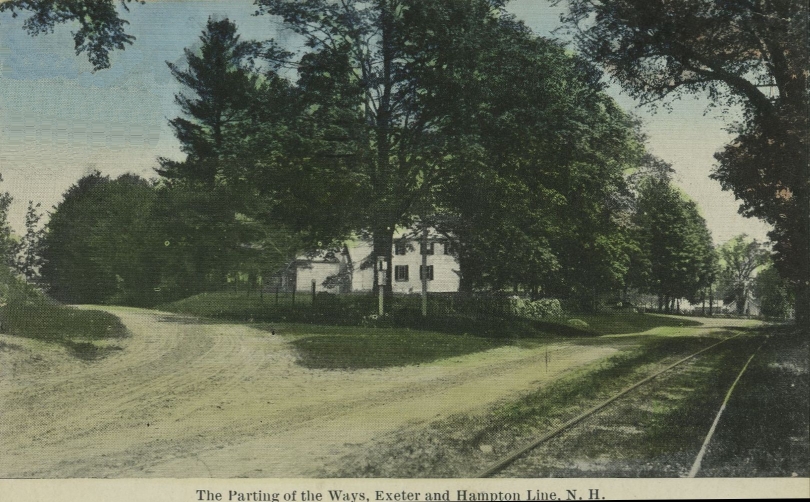
- No. 1 -
The junction of Route 111 (North Hampton Road) and 27 (Hampton Road) in Exeter, near the Exeter/Hampton town line, early 1900s. The message on the back of the postcard read, in part: "One of the beautiful places on the trolley line to Hampton Beach. Went over this route 4 times last week."
[Postcard courtesy Emile Dumont from the book "Images of America -- Hampton and Hampton Beach" by William H. Teschek - 1997 - Pg. 39]
[Postcard courtesy Emile Dumont from the book "Images of America -- Hampton and Hampton Beach" by William H. Teschek - 1997 - Pg. 39]
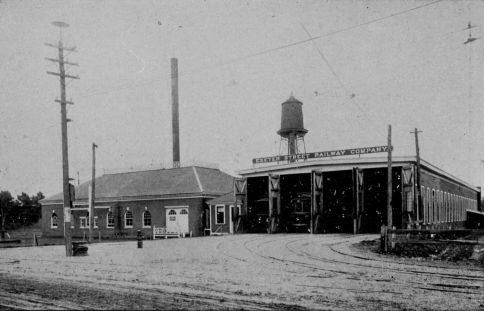
- No. 2 -
The car barn of the Exeter Street Railway Company (right), built in 1897 and burned in 1907. The powerhouse of the Exeter & Hampton Electric Company (left) was in use until 1927. The buildings at this location have changed since this picture was taken. They stand at the southwest corner of timber Swamp Road and Exeter Road (Route 27). Prior to 1939 they were converted into a community hall, basketball court and skating rink. After that it was the home of the American Legion Post 35 until 1962, when the post purchased the Hampton Grange Hall building at 69 High Street. It has held a variety of businesses since then.
[Photo courtesy Lane Memorial Library from the book "Images of America -- Hampton and Hampton Beach" by William H. Teschek - 1997 - Pg. 39]
[Photo courtesy Lane Memorial Library from the book "Images of America -- Hampton and Hampton Beach" by William H. Teschek - 1997 - Pg. 39]
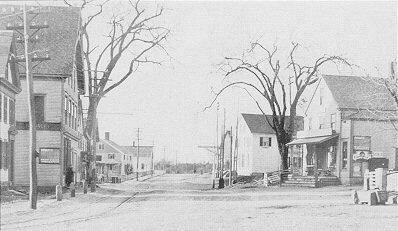
- No. 3 -
The center of town, looking west down Exeter Road, before 1900. In 1900 an overpass was built over the railroad crossing seen in the picture, and it remains so to this day. Most of the buildings on the left were moved. The Joshua A. Lane store building at far right is still there, where it was later attached to Lamie's Tavern (and named "Goody Cole Function Room" in 2001). The John A. Towle house just beyond it was moved to 65 Exeter Road.
[Photo courtesy Lane Memorial Library from the book "Images of America -- Hampton and Hampton Beach" by William H. Teschek - 1997 - Pg. 20]
[Photo courtesy Lane Memorial Library from the book "Images of America -- Hampton and Hampton Beach" by William H. Teschek - 1997 - Pg. 20]

- No. 4 -
The town pump on Exeter Road, before 1900, in front of what is now Lamie's. This popular horse-watering spot is being used by contractor Harry Brown (left) and Dr. Marvin Smith. The Howard G. Lane house at left was moved to 8 Dearborn Avenue when the railroad overpass was constructed in 1900. In this picture it stands approximately where the rear of Sanel Auto Parts is today.
[Photo courtesy Lane Memorial Library from the book "Images of America -- Hampton and Hampton Beach" by William H. Teschek - 1997 - Pg. 20]
[Photo courtesy Lane Memorial Library from the book "Images of America -- Hampton and Hampton Beach" by William H. Teschek - 1997 - Pg. 20]
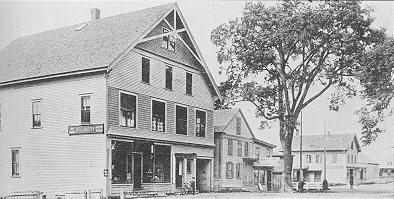
- No. 5 -
Buildings on south side of Exeter Road, Hampton center, before 1900. The railroad crossing can be seen at right. When the overpass was built, these buildings were all moved. The large Shaw Block at left was moved to 471 Lafayette Road, on the corner of High Street, and the Randolph DeLancey house to its right was moved to 294 High Street near Five Corners.
[Photo courtesy Lane Memorial Library from the book "Images of America -- Hampton and Hampton Beach" by William H. Teschek - 1997 - Pg. 21]
[Photo courtesy Lane Memorial Library from the book "Images of America -- Hampton and Hampton Beach" by William H. Teschek - 1997 - Pg. 21]
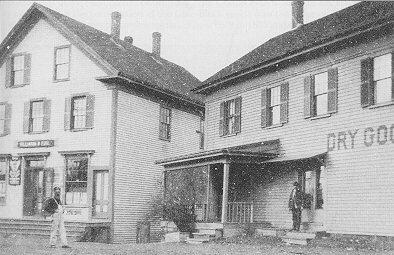
- No. 6 -
Two more businesses relocated by the railroad overpass construction, c. 1899. The John A. Towle building (right) was home to John W. Mason's dry goods store from 1875 to 1889, and the Edward B. Towle store from 1890 until the building was moved to 465 Lafayette Road, the present site of Marelli's Market. At left is the building built by Thomas N. Chase in 1883 and used by him as a store until 1890, after which it was a billiard and pool hall. It was moved to 457 Lafayette Road, later to become the Colt News Store.
[Photo courtesy Lane Memorial Library from the book "Images of America -- Hampton and Hampton Beach" by William H. Teschek - 1997 - Pg. 21]
[Photo courtesy Lane Memorial Library from the book "Images of America -- Hampton and Hampton Beach" by William H. Teschek - 1997 - Pg. 21]

- No. 7 -
Construction of the railroad overpass, 1900, looking west down Exeter Road. Some buildings have already been moved. The Chase building and pool hall at left became Colt's and the John A. Towle home at right was moved further west to 65 Exeter Road.
[Photo courtesy Lane Memorial Library from the book "Images of America -- Hampton and Hampton Beach" by William H. Teschek - 1997 - Pg. 22]
[Photo courtesy Lane Memorial Library from the book "Images of America -- Hampton and Hampton Beach" by William H. Teschek - 1997 - Pg. 22]

- No. 8 -
The town center after the buildings were moved. The Joshua A. Lane Block, shown here shortly after it was completed in 1900, now houses Hampton Center Hardware and several other small businesses. The view looks much the same today.
[Postcard courtesy Emile Dumont from the book "Images of America -- Hampton and Hampton Beach" by William H. Teschek - 1997 - Pg. 22]
[Postcard courtesy Emile Dumont from the book "Images of America -- Hampton and Hampton Beach" by William H. Teschek - 1997 - Pg. 22]
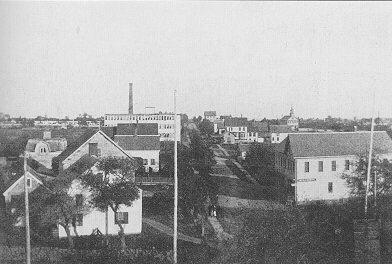
- No. 9 -
Looking east down High Street, before 1900. The Cotton Brown house at left was moved east to make way for the construction of the Lane Block and is now the office of Tobey & Merrill Insurance. The shoe factory, with smokestack, was built in 1887 and can be seen in the distance. The Hampton Academy, c. 1810, can be seen at right rear. A new brick High School was built and dedicated on June 8, 1940 and the old wooden Academy building was sold at auction for $200 and razed for salvage in July 1940.
[Photo courtesy Lane Memorial Library from the book "Images of America -- Hampton and Hampton Beach" by William H. Teschek - 1997 - Pg. 23]
[Photo courtesy Lane Memorial Library from the book "Images of America -- Hampton and Hampton Beach" by William H. Teschek - 1997 - Pg. 23]
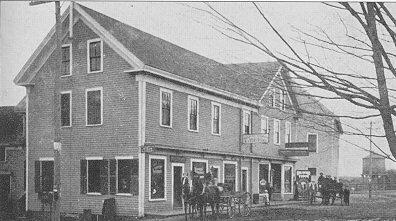
- No. 10 -
The Merrill Block, also known as the Post Office Block. Built by Dr. William T. Merrill in 1889, this block housed the post office, among other businesses, for many years. It still stands on the south side of High Street near Lafayette Road. The Shaw Block on the corner of High and Lafayette can be seen behind it, as can the railroad station water tower, which was used to supply steam engines with water for their boilers.
[Postcard courtesy Emile Dumont from the book "Images of America -- Hampton and Hampton Beach" by William H. Teschek - 1997 - Pg. 23]
[Postcard courtesy Emile Dumont from the book "Images of America -- Hampton and Hampton Beach" by William H. Teschek - 1997 - Pg. 23]
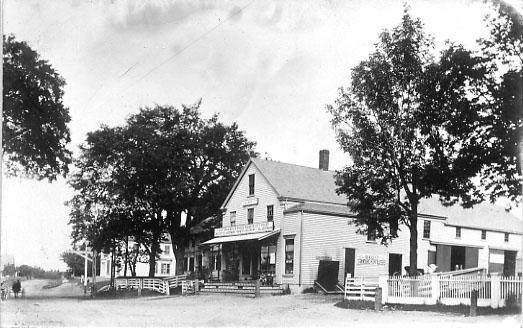
J. A. Lane Co. store, later Hampton Union office, and later "The Goody Cole Function Room" attached to "The Old Salt Eating & Drinking Place" {formerly "Lamie's Tavern"}.
[Post card courtesy Ted Scott]
[Post card courtesy Ted Scott]
[For additional information on the relocation of Exeter Road businesses, see: Small Businesses, Shops and Stores, and for more on the history of the Exeter Road bridge, see this study.]
